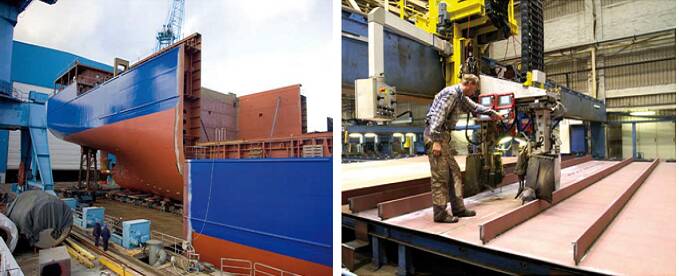Note: This article is based on the inputs from Mr. Sasianand Parthasarathy, Segment Management – National, Fronius India Private Limited.
Welding is an integral part of many industries and shipbuilding is no exception. Containers and huge structures will not be able to operate efficiently and as safely as they do without proper welding. The giant ships would need hundreds of joints to make them water-tight and oil-tight, and to make them sail smoothly over the waters.
Importance of welding in shipbuilding
Welding is an important activity in the shipbuilding industry. To protect the ship structure, the welding process should be performed by qualified welders and controlled efficiently by the quality control engineers and Classification Societies. All welders should have a certificate and the procedures should be prepared in the shipyards.
Welding in shipbuilding is said to gain more importance in the future. Most of the world’s shipping fleet will be reaching a point where vessels can no longer be practically or economically maintained as sea-worthy. A relative stagnation in demand for new ships is being revived by the requirement for replacement vessels.

Competition in this area has increased. There is a demand for suppliers to deliver high-quality products that are made quickly and at the lowest possible cost.
One of the typical solutions to meet these demands is to introduce automation. Robotic welding technology meets quality, cost, and delivery requirements and also offers flexibility in welding. Robotic welding technology can produce vessels that are priced low, meet customer needs, and more quickly. The delivery time of the vessels also reduces by this technique.
By introducing robotic welding, the welding defects sourced by the welder can be prevented. Fronius offers solutions for improving productivity, consistent quality by various high-performance welding technologies.
Welding methods used in shipbuilding
In shipbuilding, the most common technique is electrical arc welding. The areas in shipyards are generally open and exposed to the ambient air environment. Although, in some shipyards, these areas may be in large covered areas and sheltered from the weather.
Welding operations in these areas tend to be largely Shielded Metal Arc Welding (SMAW), high-performance Gas Metal Arc Welding (GMAW), and Flux-cored Arc Welding (FCAW). Rarely, other welding operations are performed in these production areas.
Materials used in this area are various grades of steel, stainless steel, aluminium, and other piping materials.
Some shipyards have specific areas where aluminium and stainless steel are welded and processed. While other shipyards that have less volume perform special welding operations at locations where space is available.
Maritime Welding Technology program
The Maritime Welding Technology program offers training in the practical aspects of construction and repair of equipment and structures built with steel. In addition to structural skills, students will learn to weld pipe in multiple positions. Training is provided in both the classroom and laboratory using modern welding equipment and tools.
Students gain hands-on experience in a realistic shop setting where they must demonstrate specific proficiencies. Emphasis is placed on safety and standard procedures followed in shipyards and repair facilities. This program prepares students for entry-level employment as a combination structural and pipe welder.
Read more from Fronius: https://nationalskillsnetwork.in/fronius/
Skills required to be a shipyard welder
Employers are paying more attention to the qualification standards with a dwindling number of highly trained and skilled welders. This means that training beyond the basics of welding will make a welder employable in a competitive, high-demand industry. Today, the best way to become a skilled shipyard welder is through a comprehensive welding training program.
This program must offer certification, classroom, and hands-on training on the latest welding tools. Experience with realistic welding tasks, in-depth skills, and training for safety protocols used in shipyards are mandatory.
Some of the most important soft skills for welding apprentices:
- The mental ability to interpret 2D and 3D diagrams and blueprints
- Physical strength and stamina to withstand hours of heat and heavy work
- Superior hand-eye coordination
- Attention to detail and excellent eyesight
These characteristics help welders produce strong, straight seams and joints. In shipbuilding, a bad weld can cost the company money, time, and their good reputation. Job applicants who fit these descriptions are less likely to make costly mistakes.
Careers for youth in welding for shipbuilding
Pipe Welders – A pipe welder is employed in shipbuilding works with many types of metals and makes welds in difficult positions and uncomfortable angles. The pipe welder works on a pipe that can’t be moved because it’s too large and heavy. The pipes’ content can also be flammable, caustic, or under high pressure. So, pipe welder must follow safety standards and procedures correctly.
Structural Welders – Structural welders need to read blueprints. They also need to know the many welding techniques used in the shipbuilding industry.
Quality Control Engineers – Engineers who are experienced in NDE/NDT procedures can pursue a career in welding quality assessments by undergoing specialized courses.
Safety gear needed by a shipyard welder
Welding safety is not something to be taken lightly. Before beginning welding, the welder must be protected from head to toe. Some of the safety gear needed by a shipyard welder are:
- Auto-darkening helmets, safety glasses/goggles
- Scalp cap
- Welding jacket
- Fire-resistant pants and gloves
- Leatherwork boots
- Earplugs
- Air respirator helmets for working in closed enclosures
Welding is a profession that is going to be needed as long as two pieces of metal need to be joined. It is an evergreen and lucrative career option for the youth who want to make a career in this field.














Welder